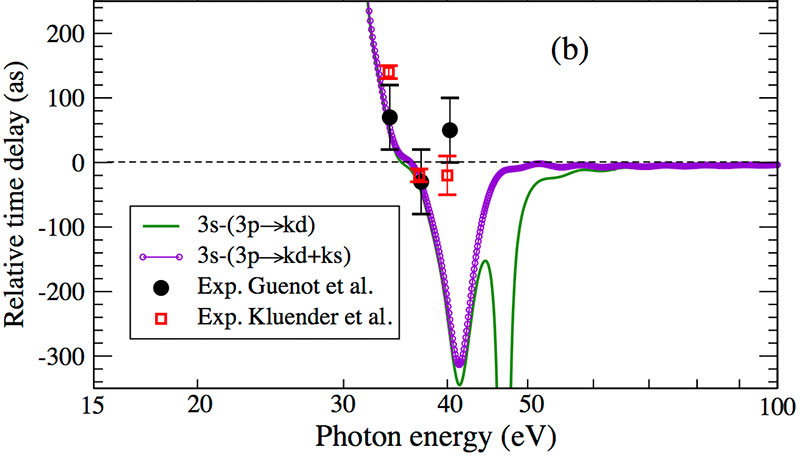Ultrashort flashes of light with just the right energy can shine on an atom confined in a fullerene cage in order to knock electrons out of various quantum levels. In a recent theoretical prediction, it is found that such a confinement shows a spectacular preference: it lets one electron to escape faster than the other. For free atoms, the delayed response of escaping electrons to light is known. But, is this behavior also true when the atom is taken hostage inside a fullerene? Recently, an attempt has been made to answer this by implanting an argon atom inside C60.
When light with enough energy impinges on matter, light transfers the energy to the matter and subsequently electrons from various quantum levels are kicked out from the matter. However, to see when matter is absorbing light was not possible until recently, i.e., whether the response time to the absorption of light is finite leading to a time delay in photoemission, or the ejection of the photoelectron occurs instantaneously. With the tremendous advancement in technology for producing ultrashort flashes of light with attosecond duration (1 as = 10-18s), it becomes possible to investigate several longstanding fundamental questions about the dynamical aspects of photoemission processes in real-time. A finite time delay between photoemission processes corresponding to different quantum levels in free atoms has been measured experimentally. The measured time delay varies as a function of impinged energy and could be several tens of attoseconds. A ubiquitous understanding in all these measurements is the dominant influence of electron correlations to determine the time behavior of ejected electrons. Therefore, the reasons for the finite time delay are attributed to the complex electron-electron interactions. To model such complex electron interactions and estimate the finite time delay during a photoemission process is very challenging. Therefore, a series of provocative experiments and theoretical studies have brought the question of finite time delay in the photoemission process to the forefront.
In a study that now was being published at Physical Review Letters [111, 203003 (2013)] http://link.aps.org/doi/10.1103/PhysRevLett.111.203003 an international team of theoretician from Qatar, USA and the Max Born Institute, have attempted to settle the dust on the finite time delay controversy in free argon atom (see Figure 1), in the work led by Gopal Dixit. The time-dependent density functional method is employed to estimate the time delay between 3s and 3p quantum levels of argon atoms. The estimated time delay is connected to the energy derivative of the quantum phase of complex photoionization amplitude. After establishing the importance of electron correlations during the estimation of time delay in a free atom, it is therefore of a spontaneous interest to extend the study to test the effect of correlations on the temporal photo-response of atoms in material confinements.
A brilliant natural laboratory for such is an atom endohedrally captured in a fullerene cage (see Figure 2) that envisions the process. There are two compelling reasons for this choice: (i) such materials are highly stable, have low-cost sustenance at the room temperature and are enjoying a rapid improvement in their synthesis techniques; and (ii) effects of correlations of the central atom with the cage electrons have been predicted to spectacularly influence the atomic valence photoionization. The space and energy proximity of the argon outer electron to a C60 electron metamorphose both into two Ar-C60 hybrid electrons. Significant ground state hybridization of Ar 3p is found to occur with the C60 3p orbital, resulting in symmetric and anti-symmetric wavefunction mixing. These overlaps are critical, since a symmetric wavefunction has a structure completely opposite to that of anti-symmetric wavefunctions over the C60 shell region where each of them strongly overlaps with a host of C60 wavefunctions to build correlations. These opposing modes of overlap from one hybrid to another flips the phase modification-direction between two hybrid 3p emissions around respective Cooper minimum. As a result the peak delay of the anti-symmetric electron is approximately double to the peak advancement (negative delay) of the symmetric electron. Due to correlations with the fullerene's electrons, one hybrid escapes faster than the other by approximately 100 attoseconds upon being illuminated by the flashes of light (see Figure 3). The source of such an intriguing behavior lies in the preservation of their quantum phase. An analogy can be drawn with the conservation of the linear momentum in a two-body collision but in the time domain. The research attempts to connect two seemingly distinct disciplines of contemporary science, nanotechnology and attoscience, and motivates towards building ultrafast light sensors, where the response time of light to nanomaterials is in the attosecond domain.
Figure above: The relative time delay between 3s and 3p quantum levels of free argon atom and its comparison with the experimental measurements at three experimental energies. Since all the ejected photoelectrons are collected in the detector, the net 3p delay must be a statistical combination, that is, the sum of the delays weighted by the photochannel’s individual cross section branching ratios. As illustrated upon including 3p→ks along with 3p→kd (purple curve) this way, the shape of the relative delay strikingly alters near 3p Cooper minimum.
 Figure 2: Schematics of probing the effect of confinement and electron correlations on the relative time delay between the 3s and 3p photoemissions of Argon confined endohedrally in C60.
Figure 2: Schematics of probing the effect of confinement and electron correlations on the relative time delay between the 3s and 3p photoemissions of Argon confined endohedrally in C60.
 Figure 3: The relative delay between 3s and hybrid 3p quantum levels (symmetric, black curve; and anti-symmetric, red curve) including the s-wave contributions and its comparison with the relative delay in free argon atom (purple curve).
Figure 3: The relative delay between 3s and hybrid 3p quantum levels (symmetric, black curve; and anti-symmetric, red curve) including the s-wave contributions and its comparison with the relative delay in free argon atom (purple curve).
Kontakt:
| Dr. Gopal Dixit, +49-30 6392-1213 |


